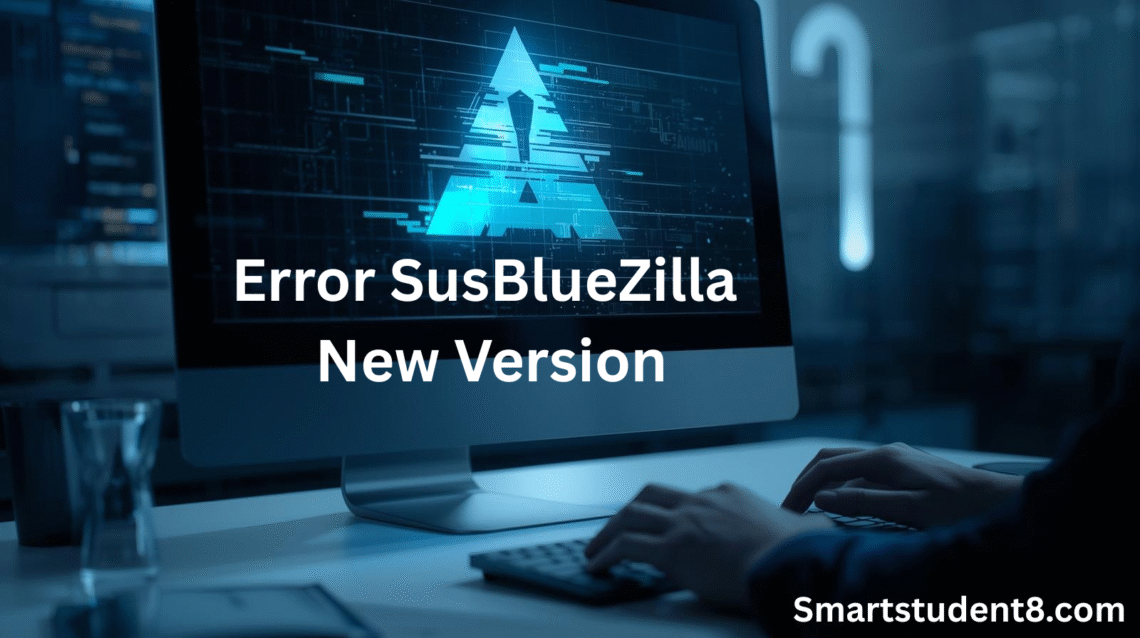It’s frustrating to be stopped in your tracks with a mysterious error message. Your screen suddenly displays “Error SusBlueZilla Version” as you try to launch a program or complete an update. This is a roadblock that can halt your workflow. You’re not the only one who has encountered this error. This error has appeared more than once in my years of troubleshooting software. This is a very common problem within the BlueZilla ecosystem.
It supports many applications. This error is the software’s attempt to tell you that there is something out of sync. It cannot verify its version, connect correctly, or locate the files needed to run. Understanding the causes of this error is important to finding a solution. This guide will take you from the causes of this error to more advanced fixes so that you can fix it and get back to your work.
Understanding the “SusBlueZilla New Version Error”
It’s important to know what the error message means before you start looking for solutions. The “Error SusBlueZilla New Version”, at its core, is a mismatch in version. You are attempting to run an application that is not compatible with either the central server of the developer or your system. Imagine trying to use an old key on a new lock. It may have worked in the past, but now it does not fit into the updated mechanism (the system or server).
Conflicts can occur in several situations, including incomplete software updates that only upgrade parts of the program, leaving other components behind. This can also occur when you attempt to run an unsupported, older version of the application on a newly updated system. This error is designed to protect the software and prevent it from being in an unstable or insecure state, which could cause data corruption or other serious problems.
This issue often indicates deeper issues than just a version number. This can be the result of corrupted files that were damaged in the download or during installation. Network interruptions often cause this. You could end up with a broken software installation if your internet connection is interrupted for even a few seconds while updating the software.
Interference from other software installed on your computer is another common cause. This error can be caused by aggressive antivirus software or firewalls that mistakenly block an application’s attempts to communicate with the server to verify its versions. Understanding these triggers will allow us to go beyond treating the symptoms and instead address the root cause.
Unpacking Common Causes of Error
In order to effectively troubleshoot, we must pinpoint what’s wrong. A single issue does not cause this error, but a combination of issues does. The solution will be much easier to find if you can identify the cause. In my many years of providing technical support, I have seen the most common triggers.
The most common cause of this is leftover files from an earlier installation. The installer should remove old files prior to adding new ones when updating software. This process can fail and leave behind old configurations, libraries or registry entries.
These remnants may conflict with the latest version and cause it to crash at launch. Imagine building a new house on an unstable, old foundation. It’s sure to cause problems. It is for this reason that a “clean“ install is recommended. This ensures that you start with a clean slate, without any data from the previous installation.
The environment in which software runs is another important factor. BlueZilla is a complex ecosystem that relies on many system components. Runtimes such as .NET Framework or Visual C++ are examples. SusBlueZilla will not function if your system lacks a dependency or runs an outdated version. The application is like a cook trying to make a meal with no essential ingredients.
If these components are not present, the application can display a version error. In the same way, outdated device drivers or operating system components, such as those for your graphics processor or network card, can cause an unstable environment, which prevents software from being initialized correctly.
We can’t ignore network-related problems. Modern applications “phone home“ frequently to a central database to verify updates, licenses or versions. This communication can be disrupted, resulting in the “Error SusBlueZilla.“ Here are some ways that your network could interfere with the program:
- Proxies and VPNs: Although useful for privacy, Virtual Private Networks (VPNs) and proxy servers redirect your internet traffic. It can interfere with the ability of an application to connect to its server and cause verification to fail. The server might not recognize or block the connection for security purposes.
- Firewalls and Antiviruses: The firewall on your system or the antivirus software from a third party monitors all network traffic, both incoming and outgoing. The security software may block connection attempts if the SusBlueZilla program is not on the list of trusted applications. This will lead to a version error.
- Unstable Internet Connection: A flaky WiFi signal or intermittent drops in connection can corrupt data packets sent between your computer and the server. The check will fail if the data used to verify the version is damaged or incomplete.
You can start by tackling the basics of troubleshooting.
It’s best to begin with the easiest solutions when faced with a problem. You would be surprised at how many complex errors can be solved with just a few simple steps. Try these troubleshooting steps before you dive into advanced settings. These are the first things I recommend to my clients, and they usually solve the problem more than half of the time.
You should always start with a restart. Both the application and the entire device should be restarted. Close and reopen the application to terminate any glitched processes and start it fresh. If this doesn’t help, restarting your computer (or smartphone) will clear the temporary memory of the system and resolve any conflicts that may be preventing the SusBlueZilla app from working properly. This is the oldest trick available in IT for a good reason: it works.
Next, check your internet connection. A poor or unstable network connection is the most likely suspect, since the “Error SusBlueZilla New Version“, is often related to version verification. Open a browser and visit a few sites to verify that your Internet works properly. Consider moving closer to the router if you’re using WiFi or plugging directly in with an Ethernet cable if you want a more stable internet connection.
If you are using a VPN service or proxy, disable it temporarily and launch the application again. You can then determine if the network routing is causing the issue. By clearing the internal cache of your router and reestablishing a new connection with your Internet service provider, a quick reset can help.
Ensure that your device, its operating system and the software are compatible. Developers regularly release updates to make use of the latest OS features and security improvements. This means that they often have to discontinue support for older operating systems. System requirements can be found on the BlueZilla official website or in the documentation of the application.
Check that your device meets the minimum requirements for RAM, storage and processor speed. Verify that the operating system you are using is supported. You will have to update the OS if it is not supported. You can update your OS on Windows by visiting Settings, Update & Security and checking for updates. For Mac users, you can update your software by going to Settings > General > Software Update. It’s important to keep your system up-to-date for both compatibility and security.
Clean Reinstallation Method
The next step is to perform a fresh reinstallation if the basic troubleshooting methods did not resolve the problem. It is the best way to fix persistent software problems because it eliminates all possible sources of conflict. Standard uninstall processes can leave behind caches, registry entries, and configuration files that may cause issues when you reinstall. Clean reinstallations go one step further, removing all traces of old software before installing the new version. This method has helped me fix hundreds of software problems over the years.
You must first uninstall SusBlueZilla using the built-in tools of your system. Windows: Go to Settings, Apps, Apps and Features. Find the application on the list and click “Uninstall.“ You can usually drag an application from the Applications directory to the Trash on macOS. This is just the first step. It is crucial to find and delete any leftover files or folders. They are typically hidden in the user-specific data folders.
- Windows: Press Windows key + R in order to open the Run dialogue. Press Enter after typing. Look for folders with the names “SusBlueZilla”, “BlueZilla”, or similar. Delete them. Check the %localappdata% directory for similar files.
- MacOS: Click “Go“ on the menu bar and hold down the “Option key“ to select “Library.“ Navigate to App Support in the Library folder and delete all folders associated with SusBlueZilla. Check the Preferences and Caches folders to see if there are any files associated.
Restart your computer once you’ve removed all traces from the previous installation. This is an important step as it releases any files that the system had locked. It’s now time to download a new copy of the installer. You should not use the installer that you saved on your computer, as it may be corrupted or outdated. Download the latest version directly from the official SusBlueZilla site.
You will get the latest, most stable and secure version of the software. Right-click the installer and choose “Run As Administrator“ in Windows. This gives the installer permission to make changes and write files into protected system directories. If you follow the installation instructions, “Error SusBlueZilla“ should be a distant memory.
Checking and updating system dependencies
BlueZilla and other modern applications are not completely self-contained. For them to work correctly, they rely on the shared libraries and runtimes that are installed on your OS. Dependencies are what they’re called. The application may not launch if a dependency is corrupted or outdated. It could also throw an error such as “SusBlueZilla New Version.“ It is important to ensure that these components are working properly as part of advanced troubleshooting.
The Visual C++ Redistributable package and .NET Framework are the most common dependencies of Windows applications. Many developers use these Microsoft platforms to build their applications. The software requires that specific versions of the runtimes be installed on the system. Go to Control Panel >Programs > Programs & Features and check the versions installed.
The list will include “Microsoft Visual C++”, “Microsoft .NET Framework“ and other entries. It is best to download the most recent versions of these packages from the Microsoft official website. Installing both the x86 and x64 versions of Visual C++ Redistributables is a good idea, since some applications require either one.
It’s important to update your device drivers in addition to the system runtimes. Drivers are tiny pieces of software which allow your operating systems to communicate with the hardware on your computer, such as your graphics card, Bluetooth radio, network adapter and more. Drivers that are outdated or corrupt can lead to a variety of performance and stability issues. A corrupted network driver may be the cause of connectivity issues that prevent version verification.
An outdated graphics driver may cause the application to crash at startup. You can usually update your drivers via the website of your computer manufacturer or directly through the manufacturer of your hardware component (e.g. NVIDIA, AMD, or Intel for graphics drivers). Windows Update often offers driver updates. Make sure that your system is up-to-date.
How to deal with network and security blockages
Suppose your problem persists after a fresh reinstallation, and you have updated all dependencies on your system without success. In that case, your security or network software is likely the culprit. They are meant to protect you, but can interfere with legitimate software due to their aggressive nature. The “SusBlueZilla New Version“, error is often caused by the application being prevented from contacting the server to verify the version.
The first place you should look is at your firewall and antivirus software. Look for the section on your main dashboard of your security suite that is related to firewall or application control. Check to see if SusBlueZilla, or any related processes, are blocked. You’ll have to create an exception to let them communicate with the Internet if you find that they are blocked.
If you cannot find the block, try this temporary test. Disable your firewall and antivirus for a couple of minutes and launch SusBlueZilla. If the error goes away, your security software was the cause. After the test, re-enable protection and create a permanent exception so that you do not have to leave your computer vulnerable.
If you don’t think your security software may be the issue, then the next step would be to check your network configuration. Disconnect from your VPN or proxy and launch the app again. You may need to configure the VPN so that it excludes SusBlueZilla from its tunnel. This feature is called “split-tunnelling.“ You may not be able to control network-level firewalls if you’re on a corporate network or a school network.
You may have to ask your IT department to whitelist an application’s server in this case. You can resolve network problems by flushing DNS caches and updating your IP address as a last resort. It can fix issues when your computer stores incorrect or outdated information about the network. You can perform this on Windows by running the following commands: ipconfig/flushdns; ipconfig/release; and ipconfig/renew.
When to seek professional help
You’ll reach a point when you have exhausted all of your options in troubleshooting. The “Error SusBlueZilla“ persists after you’ve done a fresh reinstall and updated your drivers, dependencies and security software. It’s now time to accept that you may not be able to fix the issue and ask for help. It can be harmful to continue fiddling with system settings without clear directions.
SusBlueZilla’s official support team is your first and foremost resource. Gather all relevant information before you contact the team. This will allow them to diagnose your problem faster. Prepare the following information:
- The exact application version you are installing.
- The operating system version and type (e.g. Windows 11 Pro or macOS Sonoma 145).
- Describe the steps that you have taken to resolve the problem.
- Screenshot of the exact error message.
- If you can locate them, look for the system logs. Application logs can be found in temporary folders such as %temp% and /Library/Logs/. Search for files that have recent timestamps and mention “error“ (or “fail”) “
A detailed, well-documented ticket shows you’ve done your homework and lets the technicians skip the simple questions and go straight to the core of the issue. Many companies offer a support portal where you can submit a ticket.
Don’t overlook the power of community forums. Reddit, GitHub or Discord servers dedicated to the BlueZilla community can be valuable resources. Other users may have experienced the same issue and found a solution unique to your setup. Search for posts about “SusBlueZilla New Version”. Create a new thread with the information you have gathered if you cannot find a solution. Community experience can solve many problems, even those that are difficult to resolve with official support.
Avoiding Errors in the Future
It’s great to fix the “Error SusBlueZilla New Version”, but it’s even better to ensure that this doesn’t happen again. You can save a lot of time and frustration by adopting some best practices in software management. Preventive maintenance is the best way to keep your system in top shape.
Keep your software up-to-date. This includes not only the SusBlueZilla program, but also your operating system with all of its drivers and dependencies. Enable automatic updates when possible. You will always have the most recent patches, bug fixes and security updates. This greatly reduces compatibility risks. If you update manually, make sure always to use the official source. Download installers only from official websites. Third-party sites may contain outdated or modified software, and even malware.
Be aware of the environment in which your system operates. It’s good to check the release notes for critical software before installing any major updates. In these notes, developers often mention known issues or any new system requirements. To minimize the chance of a corrupted update, you should also try to do updates on a stable connection. Consider making regular backups. It can save your life to use a tool such as Windows File History or macOS Time Machine before installing new software. You can roll back your system to its stable state within minutes if an update causes critical errors.
Conclusion
The “Error SusBlueZilla New Version”, while disruptive, is not insurmountable. You can diagnose the problem and fix it by working your way through all the possible causes, from simple restarts to network checks and clean reinstallations. Start with the simplest fixes and then move on to more complex ones if needed. This error almost always indicates a more serious conflict. Leftover files, outdated components or an overzealous antivirus program could cause it.
You are now armed with the knowledge to combat this error. Understanding what causes the error and how to avoid it will help you maintain a stable and reliable software system. Do not let a technical glitch derail your productivity. Follow these steps and be patient to get your application back up and running.





